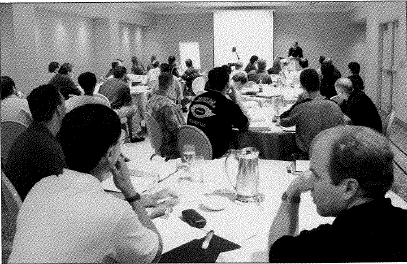
The Importance of NATCA Training
The FacRep class forms the bedrock of educating the Union’s local chapter presidents and other activists. The curriculum, which has changed over the years to adapt to new collective bargaining agreements, has always covered the spectrum of labor-management relations, including workers’ rights under federal law. In the early days, the class focused heavily on unfair labor practice charges, grievance procedures, conduct and discipline, midterm bargaining, leadership skills, and more.
Even before NATCA’s Federal Labor Relations Authority certification in 1987, very important issues arose that necessitated educating the workforce about its rights. One example is when the FAA instituted random drug testing in 1986. On Oct. 9, 1987, the union signed its first memorandum of understanding (MOU) with the Agency, outlining testing procedures.
 |
| FacRep Training. |
The need for training continued to develop early on after the birth of the Union and that first MOU. NATCA’s first President, Steve Bell, preached collaboration as the labor relations environment began to take shape in 1988. NATCA’s first Executive Vice President Ray Spickler’s philosophy was to believe in someone until they betrayed his trust. On the Agency side at the time, Deputy Associate Administrator for Air Traffic Norbert “Nobby” Owens believed in collaboration too, and the FAA’s Director of Labor and Employee Relations preferred dealing with a single entity rather than thousands of individual controllers. Collectively, those attitudes began to thaw a chilly divide of contentiousness which opened the door for more information to be shared with the workforce.
Collaboration was a hard sell in those early days. In the field, controllers were still growing accustomed to their new role as union representatives while dealing with facility managers who did not always subscribe to the notion of collaboration.
In that regard, the local reps were clamoring for help. Some educated themselves in labor law, but there was a clear need for formal training. Central Regional Representative Dan Brandt approached FAA Division Manager Ed Newburn, who suggested they attend joint classes conducted by the FLRA. At least two sessions were held.
Using instructional materials from the classes, Brandt and Kansas City Center controllers Mark Kutch and Michael Putzier held training sessions for other reps. Joseph Bellino conducted similar classes in the Great Lakes Region, as did others elsewhere.
NATCA launched an official training program in October 1989 under a contract with the now-closed George Meany Center for Labor Studies in Silver Spring, Md., just north of downtown Washington, D.C. The weeklong course covered federal sector labor relations, management rights, unfair labor practices, disciplinary and adverse actions, grievance and arbitration preparation, and a briefing on the Union’s first contract (which had been adopted the previous May). The training also included mock negotiating sessions, an invaluable component for new union reps, many of whom had little relevant experience other than haggling over the price of a car or house.
Classes were also held at the Marine Engineers Beneficial Association’s (MEBA) training facilities in Easton, Md., until the mid-1990s, when NATCA assumed responsibility. Staff members from headquarters initially taught the course, which was expanded to include sections on local finances, organizing, safety and technology, National Transportation Safety Board issues, and other topics. A year later, the regions began teaching the class with help from the national office.

